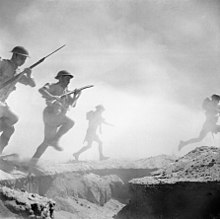Our website is made possible by displaying online advertisements to our visitors.
Please consider supporting us by disabling your ad blocker.
Second Battle of El Alamein
| Second Battle of El Alamein | |||||||
|---|---|---|---|---|---|---|---|
| Part of Western Desert Campaign | |||||||
 24 October 1942: British soldiers on the attack. | |||||||
| |||||||
| Belligerents | |||||||
|
Allies: |
Axis: | ||||||
| Commanders and leaders | |||||||
|
|
| ||||||
| Strength | |||||||
|
195,000 men [1] |
116,000 men[7][nb 5] 552 artillery pieces[5] 496 Anti Tank Guns[nb 8] – 1,063[5] | ||||||
| Casualties and losses | |||||||
|
13,560 casualties[nb 9] 332[10] – ~500 tanks[nb 10] 111 guns[9] 97 aircraft[nb 11] |
30,542 casualties[nb 12] ~500 tanks[nb 13] 254 guns[nb 14] 84 aircraft[nb 15] | ||||||
The Second Battle of El Alamein was a great turning point in the Western Desert Campaign of the Second World War. The battle lasted from 23 October to 5 November 1942. The First Battle of El Alamein had stopped the Axis from attacking deep into Egypt further. Thereafter, Lieutenant-General Bernard Montgomery took command of the British Eighth Army in August 1942. In the second battle he took the offensive, with great success.
The Allied victory turned the tide in the North African Campaign. It ended Axis's hopes of occupying Egypt, taking control of the Suez Canal, and reaching the Middle Eastern oil fields.
The battle forced Erwin Rommel and his Afrika Korps to retreat back to the former French fortifications in the Mareth Line in the border between Tunisia and Libya.
- ↑ 1.0 1.1 1.2 1.3 1.4 1.5 Playfair, p. 30
- ↑ Playfair, p. 9
- ↑ 3.0 3.1 Barr, p. 304
- ↑ 4.0 4.1 Playfair, p. 3
- ↑ 5.0 5.1 5.2 Barr, p. 276
- ↑ 6.0 6.1 Playfair, p. 10
- ↑ Buffetaut, p. 95
- ↑ Playfair, pp. 9–11
- ↑ 9.0 9.1 9.2 9.3 9.4 Playfair, p. 78
- ↑ 10.0 10.1 10.2 Barr, p.404
- ↑ Playfair, pp. 78–79
<ref group=nb> tags on this page, but the references will not show without a {{reflist|group=nb}} template (see the help page).
Previous Page Next Page
معركة العلمين الثانية Arabic İkinci Əl-Əlameyn döyüşü AZ ایکینجی العلمین دؤیوشو AZB Втора битка при Аламейн Bulgarian Segona batalla d'El Alamein Catalan Druhá bitva u El Alameinu Czech Andet slag om el-Alamein Danish Zweite Schlacht von El Alamein German Δεύτερη μάχη του Ελ Αλαμέιν Greek Second Battle of El Alamein English


